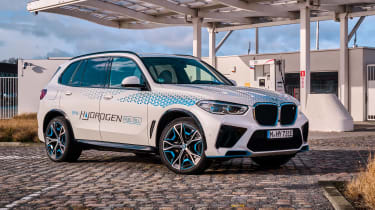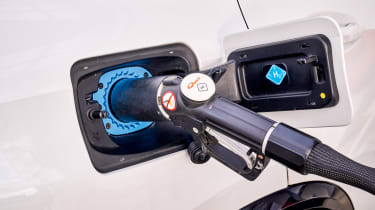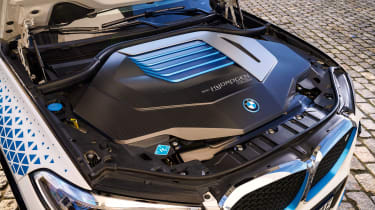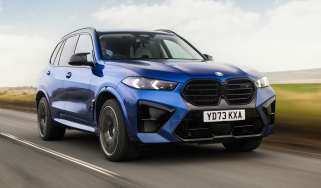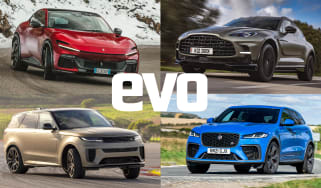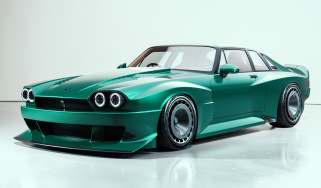Driving a hydrogen-powered BMW X5 – are fuel cells the answer?
BMW is forging ahead with trials of its hydrogen fuel cell-powered electric iX5. We try it on the road
The hydrogen-powered BMW X5 accelerates like an EV to blend with the traffic on the M3, as expected. There’s no internal combustion engine under the bonnet, the space instead occupied by a fuel cell that is being fed hydrogen and air to generate electricity which is then delivered to the rear-mounted motor and, when required, to a small but powerful battery. In fact, the only slightly unusual aspect of the experience is the sound, which starts as a woozy, Tron-like drone, like it’s running over a corrugated surface, but is escalating with ever-greater urgency. ‘It was composed by Hans Zimmer, the Hollywood composer,’ says Dr Jürgen Guldner from the passenger seat. I’m tempted to keep my foot hard in simply to discover what it sounds like at maximum speed.
Guldner is responsible for hydrogen vehicle development at BMW and this car, the iX5 Hydrogen, has been four years in the making. Coincidentally, before taking up the hydrogen role, Guldner was in chassis R&D, overseeing developing the iX5’s dynamics, so it really is his baby. The ride is supple, the handling usefully agile for a big SUV, and the performance is convincing and indistinguishable from that of a BEV (battery electric vehicle). Why bother with the complexity of a fuel cell, then? The key advantage, says Guldner, is that a hydrogen-powered FCEV (fuel cell electric vehicle) is ‘an EV with fast fuelling’. Fully refilling the iX5 with 6kg of compressed hydrogen takes only five minutes, about the same as filling a petrol or diesel car, and gives a 311-mile (500km) range, as measured by the WLTP standard.
> Hydrogen cars – how do fuel cells work and where do they fit into the alternative fuel plan?
BMW describes itself as ‘technologically agnostic’ and is touting hydrogen not as an alternative to EVs but as another tool in the race to reduce CO2 emissions. It points out that not all sectors can be electrified effectively, saying that it won’t work for coaches, trucks, aviation and maritime, or certain industries. It expects these industries to lead the way in growing the hydrogen infrastructure, which is sparse in many countries, including the UK, which has less than a dozen filling stations. We are heading for one of them, adjacent to Heathrow airport.
This iX5 Hydrogen is a ‘pilot vehicle’. Before it committed to EVs, BMW built a number of pilot cars and this FCEV pilot phase will see up to 100 iX5s released into the wild with selected customers and technology partners. It gives BMW the opportunity to understand how they are used, how they work in different situations and how people interact with them. It’s a similar programme to that undertaken by Toyota with its Mirai FCEV.
This example feels, looks and drives like a finished item. There are different drive modes, including Sport, which lifts the volume of the Zimmer soundscape, plus an adjustable level of lift-off regen, increased and decreased by the +/- steering wheel paddles. Or you can select one-pedal drive with strong lift-off braking that can bring the car to a standstill. There’s a turbocharger-like compressor feeding air to the fuel cell but it’s silent in operation, and the only emission is water.
The fuel cell is rated at 125kW, making it currently the most powerful in the world, and is built in partnership with Toyota, while the small, high-performance, lithium-ion battery pack delivers 170kW for a total of 295kW, or 396bhp, with 524lb ft of torque. There are two carbonfibre-cased tanks, which carry hydrogen compressed to 700 bar and cooled to -40deg C. All up, it’s just shy of 2500kg but about 100kg less than if it was a BEV, reckons BMW. Zero to 62mph takes less than six seconds and top speed is 115mph, which the battery can boost to 127mph for a few minutes.
‘The nice thing about this technology is the different components determine different things,’ says Guldner. ‘In a BEV, the battery determines everything, but here the tank size determines the range, the fuel cell determines the maximum speed and the battery power determines the acceleration.’ The battery has only two to three kWh, so on its own is only good for a few miles. It’s not kept 100 per cent full so that there’s room for regen braking energy. ‘It basically operates like a hybrid system, the fuel cell providing power generally, charging the battery as necessary, and the battery delivering the extra power for acceleration when required.’
Refuelling is similar to filling with petrol or diesel except there is infrared technology in the nozzle and filler neck to confirm that a sound connection has been made before compressed hydrogen begins flowing. As mentioned earlier, one issue facing hydrogen-powered vehicles in many parts is the scarcity of filling stations. Germany has just over 100, Japan over 150, but many have just a few.
Then there’s the issue with where the hydrogen comes from. Currently, the amount of ‘green’ hydrogen – produced using renewable energy – is miniscule. Most hydrogen is ‘grey’, being derived from natural gas in an energy-intense process that releases lots of CO2. Guldner sees opportunities here, pointing out that in Germany alone last year almost six terawatt hours of renewable energy was wasted because there was nowhere for it in the grid. ‘It could have been transformed into 100,000 tons of hydrogen.’
Guldner predicts that hydrogen produced from renewable energy will be the ‘new oil’ in the Middle East, those countries leveraging another natural resource: sunshine. ‘The same solar panel in the Middle East produces two and a half times more electricity than the one in Germany.
‘But there’s no electric cable to bring it to Germany, so we have to go through hydrogen to make this renewable energy available.’ Even after all the losses of electrolysing water to make hydrogen and then transporting it (as ammonia, which is much easier to transport than hydrogen), Guldner says that a solar panel in the Middle East drives an FCEV the same distance as a BEV powered by electricity from a solar panel in Germany.
Hydrogen-powered FCEVs are already factored into future models. ‘Our next architectures will have a big battery box and we want to make the hydrogen tanks smaller in diameter and then use more of them in the design space of the battery,’ says Guldner. BMW is also working on a four-wheel-drive FCEV. ‘Obviously, the packaging of the fuel cell system needs to change a little bit but the power density of those cells is still evolving. We co-operate with Toyota on the cells; we’ve been working with them for ten years now on the whole system design.’
If the hydrogen revolution is going to happen, it will be driven by other industries, such as road haulage, that need to decarbonise but can’t easily switch to battery electric. If that happens, BMW looks set to be ahead of most of its rivals with vehicles that are market-ready.
This story was first featured in evo issue 313.

